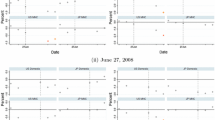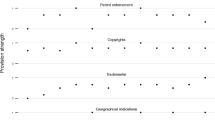Abstract
A New Look at the Impact of U.S. Import Barriers on Corporate Profit Expectations. — The notion that industries benefit from protection is firmly grounded in trade theory. However, previous “event studies” measuring the impact of trade restrictions on stock prices reveal that shareholders expect no improvement in industry profits from protection. The implication is that barriers designed to promote industry adjustment are considered ineffective by equity holders. This investigation of U.S. “Escape Clause” cases shows that shareholders do expect protection to enhance profits, but not universally. Outcomes are linked to the type of trade measure selected, with industries protected by tariffs or global quotas faring better than those shielded by nonglobal “Orderly Marketing Agreements.”
Similar content being viewed by others
References
Aw, B. Y., and M. J. Roberts (1986). Measuring Quality Change in Quota-Constrained Import Markets: The Case of U.S. Footwear.Journal of International Economics 21 (1/2): 45–60.
Binder, J. (1985). Measuring the Effects of Regulation with Stock Price Data.Rand Journal of Economics 16(2): 167–183.
Binder, J. (1998). The Event Study Methodology Since 1969.Review of Quantitative Finance and Accounting 11(2): 111–137.
Bowman, R. (1983). Understanding and Conducting Event Studies.Journal of Business Finance and Accounting 10 (4): 561–584.
Brenner, M. (1979). The Sensitivity of the Efficient Market Hypothesis to Alternative Specifications of the Market Model.Journal of Finance 34 (4): 915–929.
Brown, S., and J. Warner (1980). Measuring Security Price Performance.Journal of Financial Economics 8 (3): 205–258.
Brown, S., and J. Warner (1985). Using Daily Stock Returns: The Case of Event Studies.Journal of Financial Economics 14 (1): 3–31.
Canto, V., K. Dietrich, A. Jain, and V. Mudaliar (1986). Protectionism and the Stock Market: The Determinants and Consequences of Trade Restrictions.Financial Analysts Journal (September–October): 32–42.
Chu, C.-S. J., Operational Manual for HAC. University of Southern California. Undated. Destler, I. M. (1992).American Trade Politics. Washington: Institute for International Economics.
Derrick, C. (1988). The Evolution of the Escape Clause: The United States’ Quest for Effective Relief from Fairly Traded Imports.North Carolina Journal of International Law and Commercial Regulation 13 (2): 347–371.
Feenstra, R. (1984). Voluntary Export Restraint in U.S. Autos, 1980–81: Quality, Employment, and Welfare Effects. In R. Baldwin and A. Krueger (eds.),The Structure and Evolution of Recent U.S. Trade Policy. Chicago: University of Chicago Press.
GAO (U.S. General Accounting Office) (1981).Changes Needed in Administering Relief to Industries Hurt by Overseas Competition. Washington: Government Printing Office.
Grossman, G., and J. Levinsohn (1989). Import Competition and the Stock Market Return to Capital.American Economic Review 79 (5): 1065–1087.
Hansen, W., and T. Prusa (1993). Does Administrative Protection Protect? A Reexamination of the U.S. Title VII and Escape Clause Statutes.Regulation: The Cato Review of Business & Government 16(1). Access via: http://www.cato.org/pubs/regulation/reg16n1c.html
Hartigan, J., P. Perry, and S. Kamma (1986). The Value of Administered Protection: A Capital Market Approach.The Review of Economics and Statistics 58 (4): 610–617.
Hartigan, J., S. Kamma, and P. Perry (1989). The Injury Determination Category and the Value of Relief from Dumping.The Review of Economics and Statistics 71 (1): 183–186.
Henderson, G. (1990). Problems and Solutions in Conducting Event Studies.Journal of Risk and Insurance 57 (June): 283–306.
Hillmer, S. C., and P. L. Yu (1979). The Market Speed of Adjustment to New Information.Journal of Financial Economics 7 (4): 321–345.
Hufbauer, G. C., and K. A. Elliott (1994).Measuring the Costs of Protection in the United States. Washington: Institute for International Economics.
Hufbauer, G. C., and H. F. Rosen (1986).Trade Policy for Troubled Industries. Policy Analyses in International Economics 15. Washington: Institute for International Economics.
Hufbauer, G. C., D. Berliner, and K. Elliott (1986).Trade Protection in the United States: 31 Case Studies. Washington: Institute for International Economics.
Magee, S., and L. Young (1987). Endogenous Protection in the United States 1900–1984. In R. Stern (ed.),U.S. Trade Policies in a Changing World Economy. Cambridge, Mass.: MIT Press.
Moody’s Complete Corporate Index (various years). New York: Moody’s Investors Service.
Neary, J. P. (1978). Short-Run Capital Specificity and the Pure Theory of International Trade.Economic Journal 88 (351): 488–510.
Newey, W., and K. D. West (1987). A Simple, Positive Semi-Definite, Heteroskedasticity and Autocorrelation Consistent Covariance Matrix.Econometrica 55 (3): 703–707.
New York Times Index (various years). New York: New York Times Co.
Rosenthal, P., and R. Gilbert (1989). The 1988 Amendments to Section 201: It Isn’t Just for Import Relief Anymore.The International Law Journal of Georgetown University Law Center 20 (3): 403–440.
Ruback, R. (1983). The Cities Service Takeover: A Case Study.Journal of Finance 38 (2): 319–330.
Sykes, A. O. (1991). Protectionism as a “Safeguard”: A Positive Analysis of the GATT “Escape Clause” with Normative Speculations.The University of Chicago Law Review 58 (1): 255–305.
Sullivan, R. (2001). Some Things Exporters Should Know about U.S. Antidumping Law and Practice. Association of Food Industries, Inc. http://www.afius.org/public/content/antidumping law.htm
Thompson, A. (1994). Trade Liberalization, Comparative Advantage, and Scale Economies: Stock Market Evidence from Canada.Journal of International Economics 37 (1/2): 1–27.
Thompson, J. (1988). More Methods That Make Little Difference in Event Studies.Journal of Business Finance and Accounting 15 (1): 77–86.
USITC (U.S. International Trade Commission) (1976).Stainless and Alloy Tool Steel: Report to the President on Investigation TA-201-5. USITC Publication 0756. Washington: USITC.
USITC (U.S. International Trade Commission) (1977a).Television Receivers, Color and Monochrome, Assembled or Not Assembled, Finished or Not Finished, and Subassemblies Thereof. USITC Publication 0808. Washington: USITC. (Investigation TA-201-19).
USITC (U.S. International Trade Commission) (1977b).Footwear: Report to the President on Investigation No. TA-201-18. USITC Publication 0799. Washington: USITC.
USITC (U.S. International Trade Commission) (1978a).Bolts, Nuts & Large Screws of Iron or Steel. USITC Publication 0924. Washington: USITC. (Investigation TA-201-37).
USITC (U.S. International Trade Commission) (1978b).High-Carbon Ferrochromium. USITC Publication 0911. Washington: USITC. (Investigation TA-201-35).
USITC (U.S. International Trade Commission) (1978c).Citizens Band Radio Transceivers. USITC Publication 0852. Washington: USITC. (Investigation TA-201-29).
USITC (U.S. International Trade Commission) (1979a).Non-Electric Cookware. USITC Publication 1087. Washington: USITC. (Investigation TA-201-39).
USITC (U.S. International Trade Commission) (1979b).Clothespins. USITC Publication 0933. Washington: USITC. (Investigation TA-201-36).
USITC (U.S. International Trade Commission) (1980).Certain Motor Vehicles and Certain Chassis and Bodies Thereof. USITC Publication 1110. Washington: USITC. (Investigation TA-201-44).
USITC (International Trade Commission) (1983).Stainless and Alloy Tool Steel. USITC Publication 1377. Washington: USITC. (Investigation TA-201-48).
U.S. Tariff Commission (1973).Antifriction Balls and Ball Bearings, Including Ball Bearings with Integral Shafts, and Parts Thereof USTC Publication 597. Washington: USTC.
Wall Street Journal Index (various years). New York: Dow Jones & Co.




